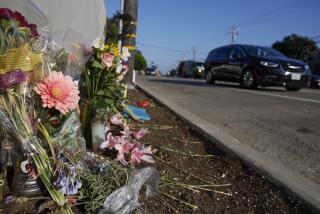Walking With Danger
- Share via
That Southern California is the most dangerous place in the state for pedestrians, particularly children, was horribly brought home last weekend. First, a Boyle Heights mother and two of her children were hit and killed by a car as they waited to cross a street on the way to school. The next day a 4-year-old in El Sereno was killed when he was struck by not one but two hit-and-run drivers.
The victims were added to a long list. A study released two weeks ago by the Surface Transportation Policy Project listed more than 1,100 child pedestrians killed or injured in Southern California in 1996. Parents of Latino children, like those whose deaths over the weekend shocked us all, more often have no cars, and thus these families are more vulnerable.
The problem knows no boundaries. Students coming and going from Hollywood High School describe a fearful race to get across congested Highland Avenue and Sunset Boulevard. “Cars get angry at kids,” one 15-year-old told a Times reporter. “They get impatient and almost run over kids.” And, as the study noted, the more unfriendly the streets, the less people walk, to their detriment and the city’s.
There is no magic cure. For instance, the gated Orange County community of Coto de Caza installed speed bumps but removed them when they were found to impede emergency vehicles. But areas for improvement are clear.
* Policing. Glendale’s hugely successful safety program, ticketing drivers who break crosswalk laws, as well as jaywalkers, should be copied, along with a public service campaign warning drivers. Police should steadily and consistently ticket speeders and those who run red lights and stop signs.
* Driver training. Restore driver training in every high school and perhaps extend it to the continuation schools where many immigrants study English. The Department of Motor Vehicles’ finding last year that more than half of license applicants fail the written test was a sobering wake-up.
* High technology. Sensors placed in crosswalks, for instance, can trigger flashing lights when a pedestrian steps off the curb.
* Low technology. Well-separated bike lanes, wide and tree-shaded sidewalks and common-sense use of speed tables (lower, flatter bumps), traffic circles, well-marked crosswalks and stop signs can all help.
Pedestrian safety is woefully underfunded at every level, but Gov. Gray Davis gave children some help with his last-minute signature on AB 1475, directing $20 million in federal funding toward safety measures along routes to neighborhood schools. It’s hard to change a car culture, but last weekend’s headlines should make it easier to start.
More to Read
Sign up for Essential California
The most important California stories and recommendations in your inbox every morning.
You may occasionally receive promotional content from the Los Angeles Times.













